Weed Abundance, Seed Bank in Different Soil Tillage Systems, and Straw Retention
Abstract
1. Introduction
2. Materials and Methods
2.1. Study Sites
- Without straw (S0);
- With straw (S1).
- Conventional (deep) plowing at a depth of 23–25 cm (CP), control;
- Shallow plowing at a depth of 10–12 cm (SP);
- Shallow cultivation at a depth of 8–10 cm (SC);
- Stubble over winter and shallow cultivation before sowing at a depth of 4–5 cm (SOW);
- No till with cover crops (NTC);
- No till without cover crops (NT).
2.2. Weeds in Crop Field
2.3. Crop Weed Seed Bank
2.4. Meteorological Conditions
2.5. Statistical Analysis
2.6. Comprehensive Assessment of Different Tillage Systems and Straw Methods
3. Results
3.1. Weeds in Crop Fields
3.2. Weed Seed Bank
3.3. Comprehensive Assessment of Different Tillage Systems and Straw
4. Discussion
4.1. Weeds in Crop Fields
4.2. Weed Seed Bank
5. Conclusions
Author Contributions
Funding
Data Availability Statement
Conflicts of Interest
References
- Mantel, S.; Dondeyne, S.; Deckers, S. World reference base for soil resources (WRB). In Encyclopedia of Soils in the Environment; Elsevier: Amsterdam, The Netherlands, 2023; pp. 206–217. [Google Scholar]
- Harker, K.N.; O’Donovan, J.T. Recent Weed Control, Weed Management, and Integrated Weed Management. Weed Technol. 2013, 1, 1–11. [Google Scholar] [CrossRef]
- Balick, M.J.; Cox, P.A. Plants, People, and Culture: The Science of Ethnobotany; Garland Science: New York, NY, USA, 2020; p. 228. [Google Scholar] [CrossRef]
- Romaneckas, K.; Romaneckienė, R.; Šarauskis, E.; Pilipavičius, V.; Sakalauskas, A. The effect of conservation primary and zero tillage on soil bulk density, water content, sugar beet growth, and weed infestation. Agron. Res. 2009, 7, 73–86. [Google Scholar]
- Romaneckas, K.; Kimbirauskienė, R.; Sinkevičienė, A.; Jaskulska, I.; Buragienė, S.; Adamavičienė, A.; Šarauskis, E. Weed diversity, abundance, and seed bank in differently tilled faba bean (Vicia faba L.) cultivations. Agronomy 2021, 11, 529. [Google Scholar] [CrossRef]
- Van Groenigen, K.J.; Bloem, J.; Bååth, E.; Boeckx, P.; Rousk, J.; Bode, S.; Forrista, D.; Jones, M. Abundance, production and stabilization of microbial biomass under conventional and reduced tillage. Soil Biol. Biochem. 2010, 42, 48–55. [Google Scholar] [CrossRef]
- Tørresen, K.S.; Skuterud, R.; Tandsaether, H.J.; Hagemo, M.B. Long term experiments with reduced tillage in spring cereals. I. Effects on weed flora, weed seed bank and grain yield. Crop Prot. 2003, 22, 185–200. [Google Scholar] [CrossRef]
- Hoffmann, J.H.; Moran, V.C. Assigning success in biological weed control: What do we really mean? In Proceedings of the XII International Symposium on Biological Control of Weeds, La Grande Motte, France, 22–27 April 2007; CAB International: Wallingford, UK, 2008; pp. 687–692. [Google Scholar]
- Alsaadawi, A.S.; Dayan, F.E. Potentials and prospects of sorghum allelopathy in agroecosystems. Allelopath. J. 2009, 24, 255–270. [Google Scholar]
- Lahmod, N.R. Allelopathic Effects of Sorghum (Sorghum bicolor L.) Moench on Companion Weeds and Subsequence Crop. Ph.D. Thesis, Field Crop Science, College of Agricultural, University of Baghdad, Baghdad, Iraq, 2012. [Google Scholar]
- Finney, D.M.; Creamer, N.G.; Weed Management on Organic Farms. Organic Center for Environmental Farming Systems. A Cooperative Effort Between North Carolina State University, North Carolina A T State University, and the North Carolina Department of Agriculture and Consumer Services 2008. Available online: https://cefs.ncsu.edu/ (accessed on 4 February 2007).
- Clark, A. Managing Cover Crops Profitably, 3rd ed.; Sup Handbook; United Book Press, Inc.: Bensalem, PE, USA, 2012; Available online: https://www.sare.org/publications/covercrops/covercrops.pdf (accessed on 4 February 2007).
- Shaner, D.L.; Beckie, H.J. The future for weed control and technology. Pest Manag. Sci. 2014, 70, 1329–1339. [Google Scholar] [CrossRef]
- Chauhan, B.S.; Gill, G.S.; Preston, C. Tillage system effects on weed ecology, herbicide activity and persistence: A review. Aust. J. Exp. Agric. 2006, 46, 1557–1570. [Google Scholar] [CrossRef]
- Dayan, F.E. Current status and future prospects in herbicide discovery. Plants 2019, 8, 341. [Google Scholar] [CrossRef]
- Nawaz, A.; Farooq, M.; Nadeem, F.; Siddique, K.H.; Lal, R. Rice–wheat cropping systems in South Asia: Issues, options and opportunities. Crop Pasture Sci. 2019, 70, 395–427. [Google Scholar] [CrossRef]
- Kosteckienė, S. Regularities of Development and Yields of Spring Rapeseed (Brassica napus L.) Sown at Different Dates. Ph.D. Thesis, Vytautas Didysis University, Kaunas, Akademija, 2022; p. 181. [Google Scholar]
- Yalew, S.G.; Vliet, M.T.; Gernaat, D.E.; Ludwig, F.; Miara, A.; Park, C.; Vuuren, D.P. Impacts of climate change on energy systems in global and regional scenarios. Nat. Energy 2020, 5, 794–802. [Google Scholar] [CrossRef]
- Meena, S.D.; Susank, M.; Guttula, T.; Chandana, S.H.; Sheela, J. Crop yield improvement with weeds, pest and disease detection. Procedia Comput. Sci. 2023, 218, 2369–2382. [Google Scholar] [CrossRef]
- Zhang, Q.; He, Z.; Wang, J. Acute Toxicity, Oxidative Stress, Toxicity Mechanism, and Degradation Dynamics of Trifluralin in Eisenia foetide (Annelida: Lumbricidae). J. Entomol. Sci. 2023, 58, 27–46. [Google Scholar] [CrossRef]
- Gallandt, E.R.; Liebman, M.; Huggins, D.R. Improving soil quality: Implications for weed management. J. Crop Prod. 1999, 2, 95–121. [Google Scholar] [CrossRef]
- Geddes, C.M.; Tidemann, B.D.; Ikley, J.T.; Dille, J.A.; Soltani, N.; Sikkema, P.H. Potential spring canola yield losses due to weeds in Canada and the United States. Weed Technol. 2022, 36, 884–890. [Google Scholar] [CrossRef]
- Shamshitov, A.; Kadžienė, G.; Supronienė, S. The Role of Soil Microbial Consortia in Sustainable Cereal Crop Residue Management. Plants 2024, 13, 766. [Google Scholar] [CrossRef] [PubMed]
- Sudianto, E.; Neik, T.X.; Tam, S.M.; Chuah, T.S.; Idris, A.A.; Olsen, K.M.; Song, B.K. Morphology of Malaysian weedy rice (Oryza sativa): Diversity, origin and implications for weed management. Weed Sci. 2016, 64, 501–512. [Google Scholar] [CrossRef]
- Marcinkevičienė, A.; Keidan, M.; Pupalienė, R.; Velička, R.; Kriaučiūnienė, Z.; Butkevičienė, L.M.; Kosteckas, R. Nonchemical weed control in winter oilseed rape crop in the organic farming system. In Organic Agriculture; IntechOpen: London, UK, 2017; pp. 121–131. [Google Scholar]
- Tuskenytė, V.; Volungevičius, J. Aplinkos Apsaugos Raidos Problema Lietuvoje. Geologija. Geogr. 2015, 1, 105–115. [Google Scholar] [CrossRef]
- IUSS Working Group WRB. World Reference Base for Soil Resources 2020. In International Soil Classification System for Naming Soils and Creating Legends for Soil Maps; Update 2023. World Soil Resources Report; FAO: Rome, Italy, 2020; pp. 1–13. [Google Scholar]
- Stancevičius, A. Weed Accounting and Weed Field Mapping; Mokslas: Vilnius, Lithuania, 1979. (In Lithuanian) [Google Scholar]
- Stancevičius, A. New Rational Method for Determining Weed Seed Content in the Soil. Agronomy, Land Reclamation and Hydro-Engineering; Lithuanian University of Agriculture: Kaunas, Lithuania, 1980. (In Lithuanian) [Google Scholar]
- Guan, G.Q.; Zhang, Y.R.; Sun, G.Y.; Ding, S.X.; Wang, Y.B. Illustrated Handbook of Weed Seed; Science Press: Beijing, China, 2000. (In Chinese) [Google Scholar]
- Vasileiadis, V.P.; Froud-Williams, R.J.; Eleftherohorinos, I.G. Vertical distribution, size and composition of the weed seed bank under various tillage and herbicide treatments in a sequence of industrial crops. Weed Res. 2007, 47, 222–230. [Google Scholar] [CrossRef]
- Leonavičienė, T. SPSS Programų Paketo Taikymas Statistiniuose Tyrimuose; Vilniaus Pedagoginio Universiteto Leidykla: Vilnius, Lithuania, 2007; p. 126. [Google Scholar]
- Raudonius, S. Application of statistics in plant and crop research: Important issues. Zemdirb.-Agric. 2017, 104, 377–382. [Google Scholar] [CrossRef]
- Lohmann, G. Entwicklung Eines Bewertungsverfahrens Für Anbausysteme Mit Differenzierten Aufwandmengen Ertragssteigernder und Ertragssichernder Betriebsmittel. Ph.D. Dissertation, Institut für Pflanzenbau der Rheinischen Friedrich-Wilhelms-Universität Bonn, Bonn, Germany, 1994. [Google Scholar]
- Heyland, K.U. Zur Methodik einer integrierten Darstellung und Bewertung der Produktionverfahren im Pflanzenbau. Pflanzenbauwissenscgaften 1998, 2, 145–159. [Google Scholar]
- Mauer, K.; Hellmann, S.L.; Groth, M.; Fröbius, A.C.; Zischler, H. The genome, transcriptome, and proteome of the fish parasite Pomphorhynchus laevis (Acanthocephala). PLoS ONE 2020, 15. [Google Scholar] [CrossRef] [PubMed]
- Pliūra, A.; Bajerkevičienė, G.; Suchockas, V.; Lygis, V.; Jankauskienė, J. Septynių miško medžių rūšių atsakas į su klimato kaita susijusių veiksnių-šalnų, karščio, sausrų, didesnio intensyvumo UV spinduliuotės ir didesnių ozono bei anglies dioksido koncentracijų kompleksinį poveikį jauname amžiuje. Agrariniai ir Miškininkystės Mokslai: Naujausi Tyrimų Rezultatai ir Inovatyvūs Sprendimai: Mokslinės Konferencijos Pranešimai. 2019, Volume 9, pp. 45–48. Available online: https://scholar.google.com/scholar?hl=en&as_sdt=0%2C5&q=Pli%C5%ABra%2C+A.%3B+Bajerkevi%C4%8Dien%C4%97%2C+G.%3B+Suchockas%2C+V.%3B+Lygis%2C+V.%3B+Jankauskien%C4%97%2C+J.+Septyni%C5%B3+mi%C5%A1ko+med%C5%BEi%C5%B3+r%C5%AB%C5%A1i%C5%B3+atsakas+%C4%AF+su+klimato+kaita+susijusi%C5%B3+veiksni%C5%B3-%C5%A1aln%C5%B3%2C+kar%C5%A1%C4%8Dio%2C+sausr%C5%B3%2C+didesnio+intensyvumo+UV+spinduliuot%C4%97s+ir+didesni%C5%B3+ozono+bei+anglies+di-oksido+koncentracij%C5%B3+kompleksin%C4%AF+poveik%C4%AF+jauname+am%C5%BEiuje.+In+Agrariniai+ir+Mi%C5%A1kininkyst%C4%97s+Mokslai%3A+Naujausi+Tyrim%C5%B3+Rezultatai+ir+Inovatyv%C5%ABs+Sprendimai%3A+Mokslin%C4%97s+Konferencijos+Prane%C5%A1imai%3B+2019%3B+Volume+9%2C+pp.+45%E2%80%9348.&btnG= (accessed on 4 February 2007).
- Rašomavičius, V. Laukų Augalijos Tyrimai: Mokslinė Ataskaita; LAMMC: Vilnius, Lithuania, 2008; p. 74. [Google Scholar]
- Blackshaw, R.E.; Anderson, R.L.; Lemerle, D. Cultural Weed Management. Non-Chemical Weed Management: Principles, Concepts and Technology; CAB International: Wallingford, UK, 2007; pp. 35–48. [Google Scholar]
- Kassam, A. Conservation agriculture for regenerative and resilient production systems. In Biological Approaches to Regenerative Soil Systems; CRC Press: Boca Raton, FL, USA, 2023; pp. 251–264. [Google Scholar]
- Vilde, A.; Lapins, D.; Dinaburga, G.; Cesnieks, S.; Valainis, O. Investigations in precise agriculture: Results, problems, perspective development. Eng. Rural. Dev. 2012, 11, 74–80. [Google Scholar]
- Laguerre, G.; Contreras, A., Jr.; Hanson, B.D. Evaluation of weed control efficacy and crop safety of the PPO-inhibiting herbicide tiafenacil in California orchard cropping systems. Weed Technol. 2024, 38, 46–63. [Google Scholar] [CrossRef]
- Marcinkevičienė, A.; Bogužas, V. The influence of catch crops and manure on soil bioactivity in sustainable and organic farming. Žemdirbystė 2006, 93, 146–154. [Google Scholar]
- Velykis, A.; Satkus, A. Weed infestation and changes in field pea (Pisum sativum L.) yield as affected by reduced tillage of a clay loam soil. Zemdirb.-Agric. 2010, 97, 73–82. [Google Scholar]
- Juchnevičienė, A.; Raudonius, S.; Avižienytė, D.; Romaneckas, K.; Bogužas, V. Ilgalaikio supaprastinto žemės dirbimo ir tiesioginės sėjos įtaka žieminių kviečių pasėliui. Žemės Ūkio Moksl. 2012, 19, 139–150. [Google Scholar] [CrossRef]
- Skuodienė, R. The influence of primary soil tillage, deep loosening and organic fertilizers on weed incidence in crop. Žemdirbystė 2016, 103, 135–142. [Google Scholar]
- Murad, N.Y.; Mahmood, T.; Forkan, A.R.M.; Morshed, A.; Jayaraman, P.P.; Siddiqui, M.S. Weed detection using deep learning: A systematic literature review. Sensors 2023, 23, 3670. [Google Scholar] [CrossRef]
- Bachheti, A.; Sharma, A.; Bachheti, R.K.; Husen, A.; Pandey, D.P. Plant allelochemicals and their various applications. In Co-Evolution of Secondary Metabolites; Springer: Berlin/Heidelberg, Germany, 2020; pp. 441–465. [Google Scholar]
- Eimutytė, E.; Adamavičienė, A.; Pupalienė, R.; Oksas, M.; Kimbirauskienė, R.; Čekanauskas, S.; Romaneckas, K. Effect of Non-chemical Weed Control Systems on Weediness of Organically Grown Sugar Beet Crop; International Scientific Conference: AgroEco2016: Programme and Abstracts; Aleksandro Stulginskio University: Kaunor, Akademija, 2016; Volume 23, pp. 103–113. [Google Scholar]
- Almoussawi, M.; Abdallah, A.M.; Habanjar, K.; Awad, R. Effect of (Sm, Co) co-doping on the structure and electrical conductivity of ZnO nanoparticles. Mater. Res. Express 2020, 7, 105011. [Google Scholar] [CrossRef]
- Hossain, M.A.; Khoo, K.T.; Cui, X.; Poduval, G.K.; Zhang, T.; Li, X.; Hoex, B. Atomic layer deposition enabling higher efficiency solar cells: A review. Nano Mater. Sci. 2020, 2, 204–226. [Google Scholar] [CrossRef]
- Jastrzębska, M.; Kostrzewska, M.K.; Marks, M.; Jastrzębski, W.P.; Treder, K.; Makowski, P. Crop rotation compared with continuous rye cropping for weed biodiversity and rye yield. A case study of a long-term experiment in Poland. Agronomy 2019, 9, 644. [Google Scholar] [CrossRef]
- Mockevičienė, R. Necheminių Piktžolių Kontrolės Priemonių ir Biologinių Preparatų Įtaka Vasarinių Rapsų Agrocenozei. Ph.D. Dissertation, Aleksandro Stulginskio Universitetas, Kaunas, Lithuania, 2017; p. 133. [Google Scholar]
- Marcinkevičienė, A.; Velička, R.; Mockevičienė, R.; Pupalienė, R.; Kriaučiūnienė, Z.; Butkevičienė, L.M.; Kosteckas, R.; Čekanauskas, S. Non-chemical weed control systems in organically grown spring oilseed rape. Acta Fytotechnol. zootechnol. 2015, 18, 34–36. [Google Scholar] [CrossRef]
- Alarcón, R.; Hernández-Plaza, E.; Navarrete, L.; Sánchez, M.J.; Escudero, A.; Hernanz, J.L.; Sánchez, A.M. Effects of no-tillage and non-inversion tillage on weed community diversity and crop yield over nine years in a Mediterranean cereal-legume cropland. Soil Tillage Res. 2018, 179, 54–62. [Google Scholar] [CrossRef]
- Winkler, J.; Dvořák, J.; Hosa, J.; Martínez Barroso, P.; Vaverková, M.D. Impact of conservation tillage technologies on the biological relevance of weeds. Land 2022, 12, 121. [Google Scholar] [CrossRef]
- Kutbay, H.G.; Sürmen, B. Ellenberg ecological indicator values, tolerance values, species niche models for soil nutrient availability, salinity, and pH in coastal dune vegetation along a landward gradient (Euxine, Turkey). Turk. J. Bot. 2022, 46, 346–360. [Google Scholar] [CrossRef]
- Avižienytė, D.; Romaneckas, K.; Pališkytė, R.; Bogužas, V.; Pilipavičius, V.; Šarauskis, E.; Vaiciukevičius, E. The impact of long-term reduced primary soil tillage on maize (Zea mays L.) productivity. Zemdirb.-Agric. 2013, 100, 377–382. [Google Scholar] [CrossRef]
- Wojciechowski, W.; Józef, S. Changes in the number of weed seeds in soil under different tillage systems of winter wheat. J. Plant Prot. Res. 2005, 83–92. Available online: https://journals.pan.pl/Content/118589/PDF-MASTER/083-092_Changes%20in%20the%20number%20of.pdf (accessed on 4 February 2007).
- Derksen, D.A.; Lafond, G.P.; Thomas, A.G.; Loeppky, H.A.; Swanton, C.J. Impact of agronomic practices on weed communities: Tillage systems. Weed Sci. 1993, 41, 409–417. [Google Scholar] [CrossRef]
- Pantović, J.G.; Sečanski, M. Weed Control in Organic Farming. Contemp. Agric. 2023, 72, 43–56. [Google Scholar] [CrossRef]
- Webber, C.L., III; White, P.M., Jr.; Boydston, R.A.; Shrefler, J.W. Impact of Mustard Seed Meal Applications on Direct Seeded Cucurbits and Weed Control. J. Agric. Sci. 2017, 9, 68–81. [Google Scholar] [CrossRef][Green Version]
- Pedda Ghouse Peera, S.K.; Debnath, S.; Maitra, S. Mulching: Materials, Advantages and Crop Production. In Protected Cultivation and Smart Agriculture; Maitra, S., Gaikwad, D.J., Shankar, T., Eds.; New Delhi Publishers: New Delhi, India, 2020; pp. 55–66. [Google Scholar]
- Auškalnienė, O.; Kadžienė, G.; Janušauskaitė, D.; Supronienė, S. Changes in weed seed bank and flora as affected by soil tillage systems. Zemdirb.-Agric. 2018, 105, 221–226. [Google Scholar] [CrossRef]
- Scherner, A.; Melender, B.; Kudsk, P. Vertical distributions and composition of weed seeds within the plough layer after elever yers of contrasting crop rotation and tillage scheme. Soil Tillage Res. 2016, 161, 135–142. [Google Scholar] [CrossRef]
- Stancevičius, A.; Pupalienė, R. Įvairaus intensyvumo žemdirbystės sistemų liekamasis poveikis miežių pasėlio piktžolėtumui. Žemės Ūkio Moksl. 2003, 2, 3–14. [Google Scholar]
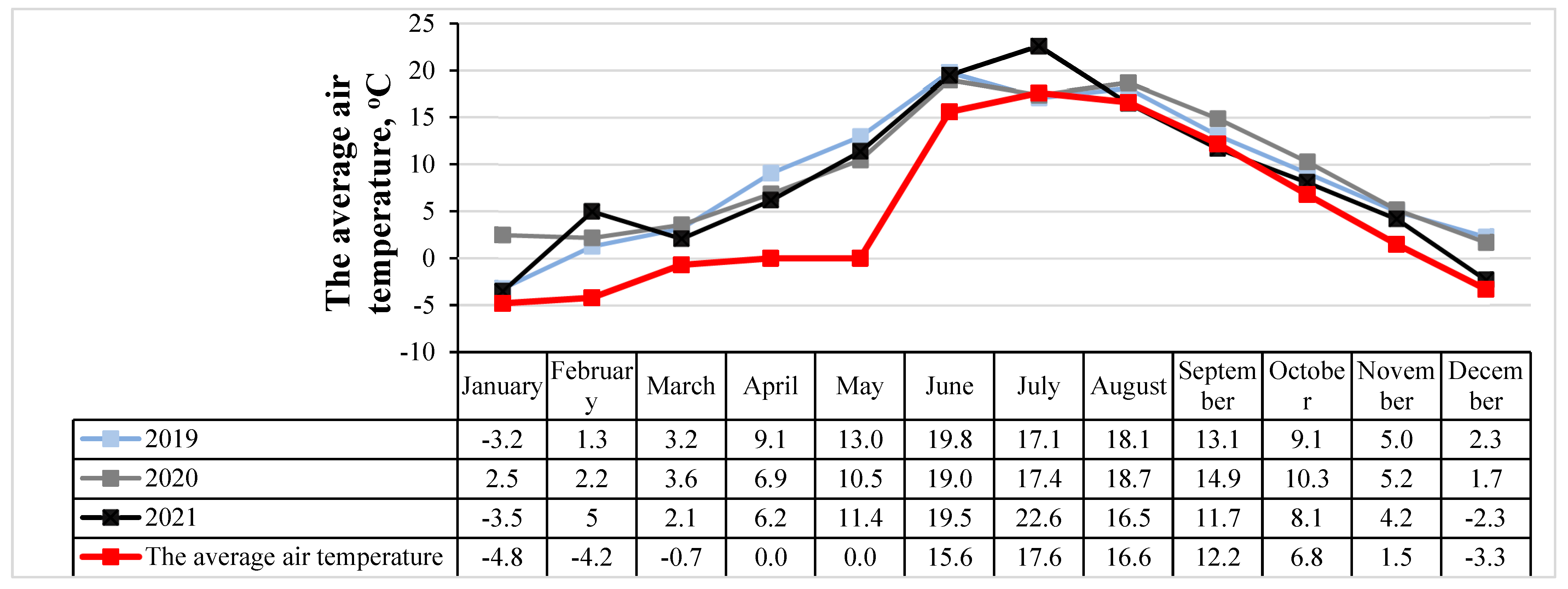
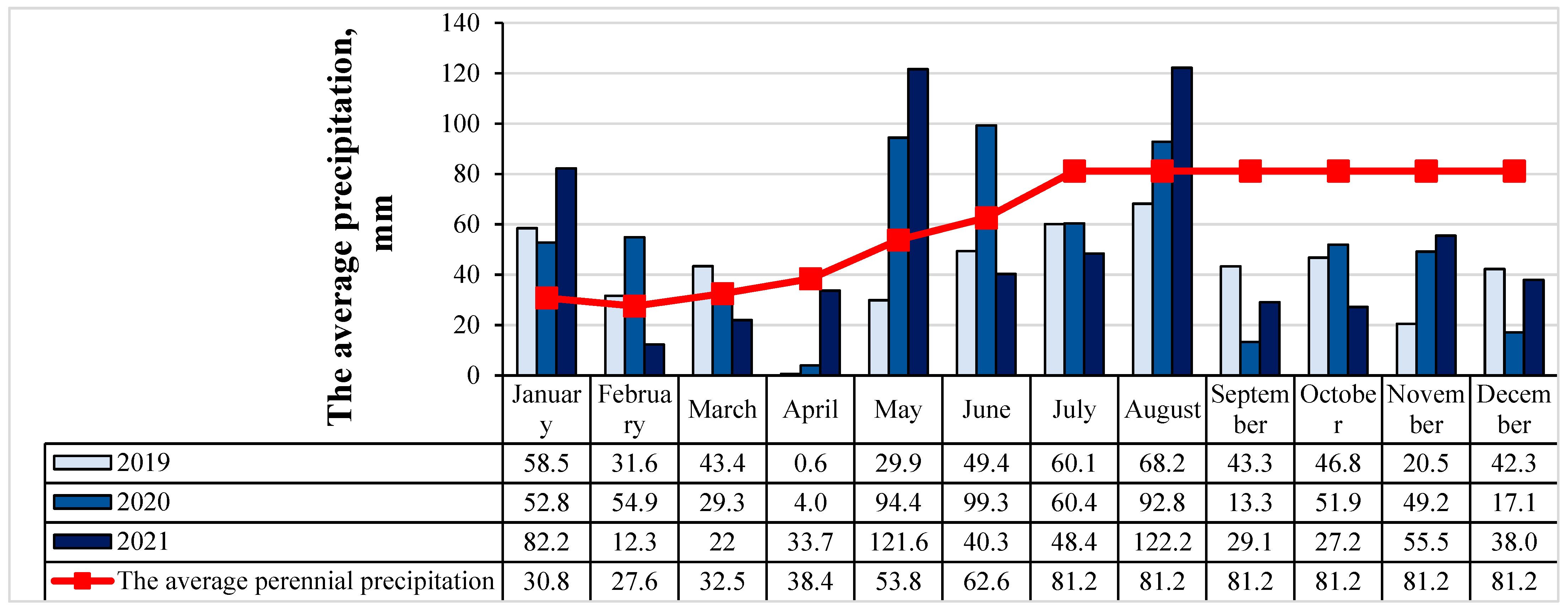
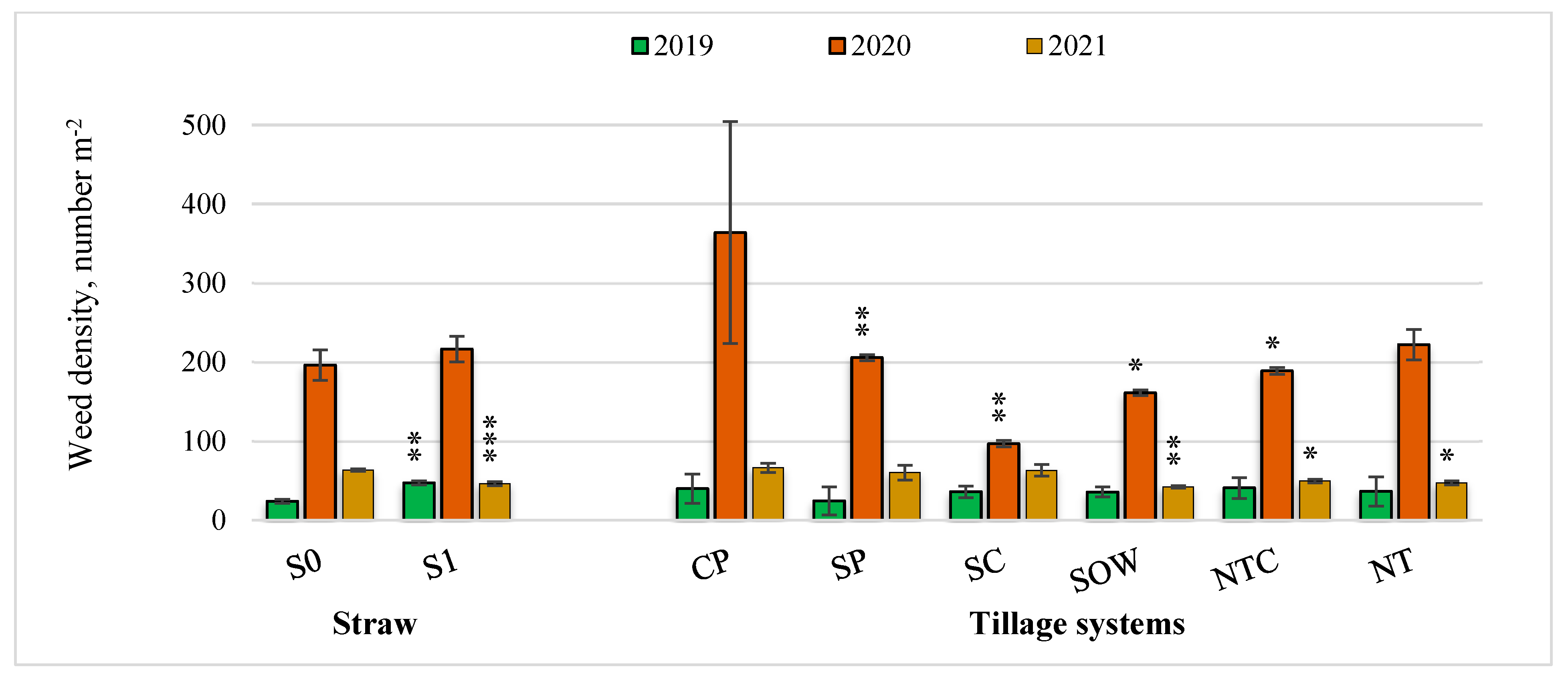
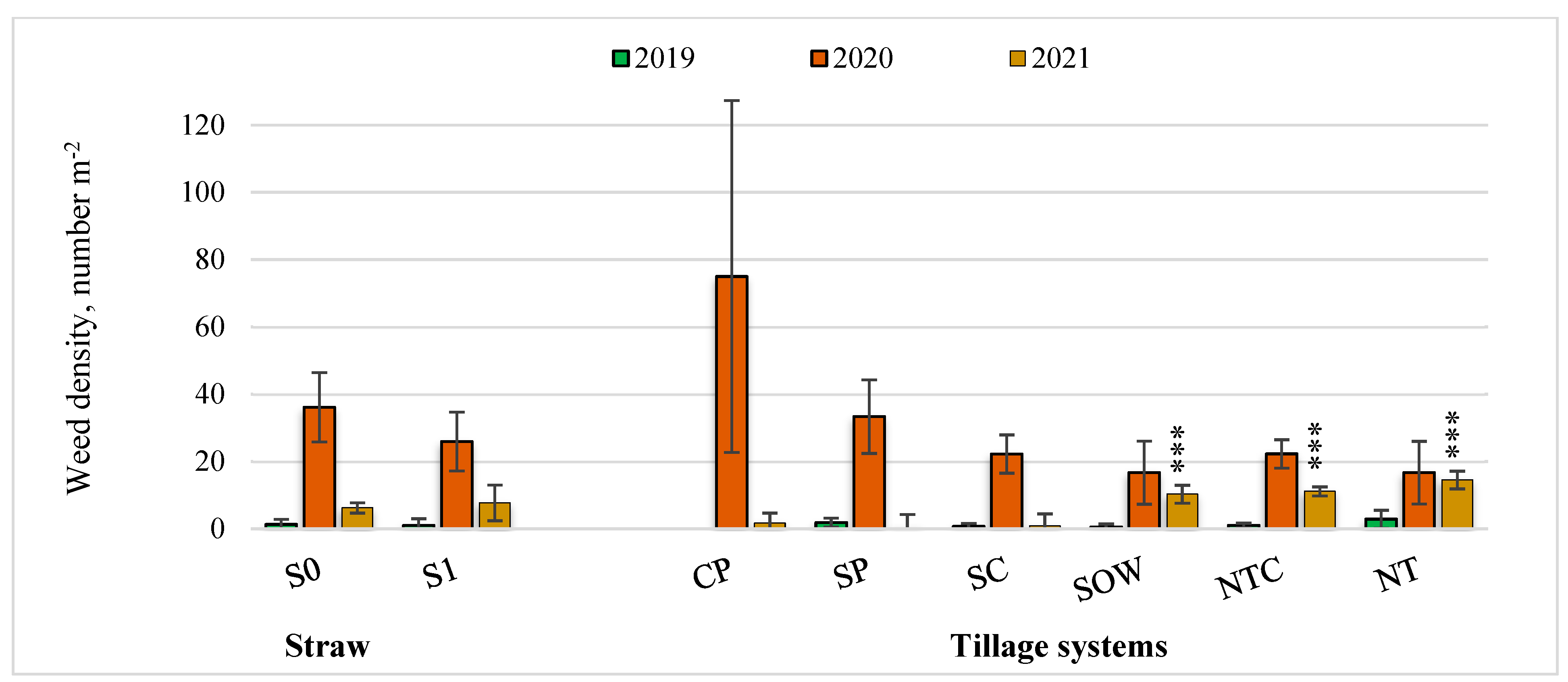
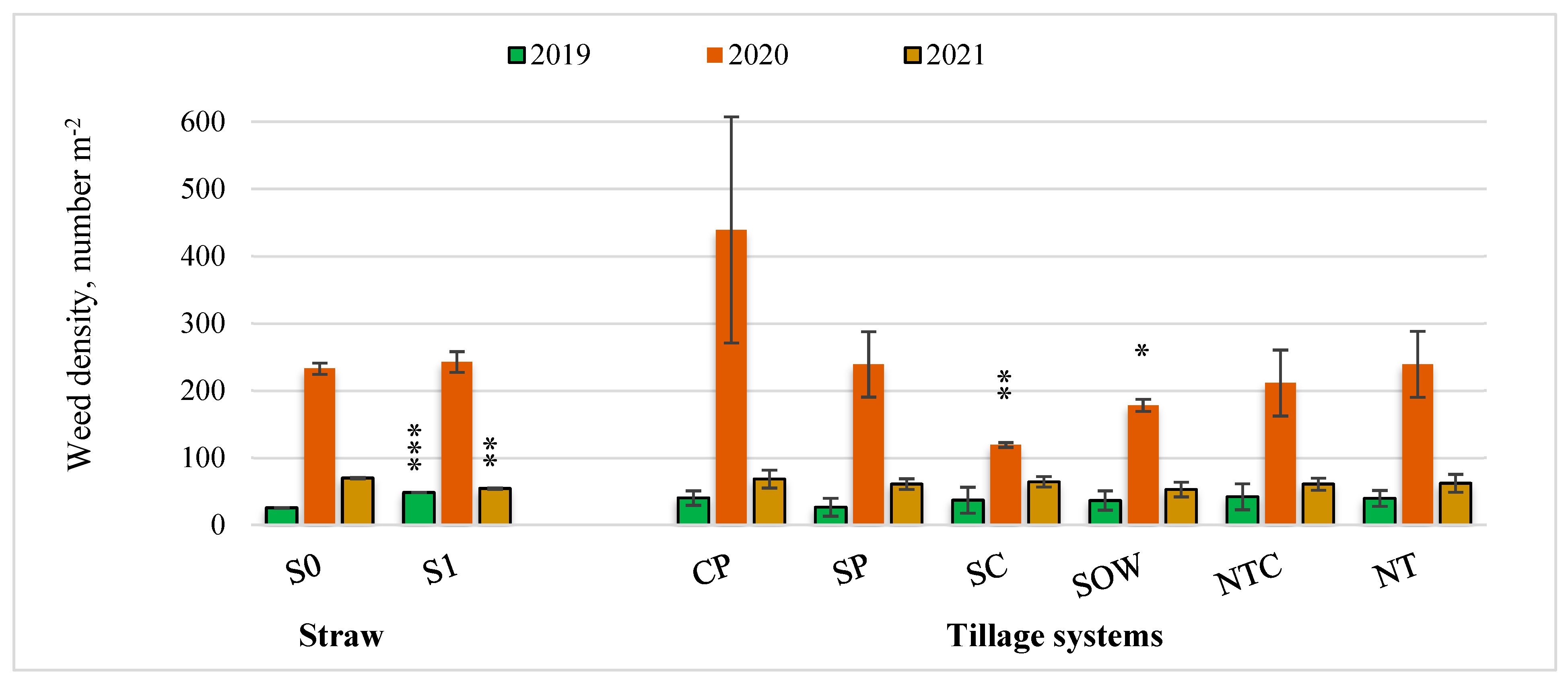
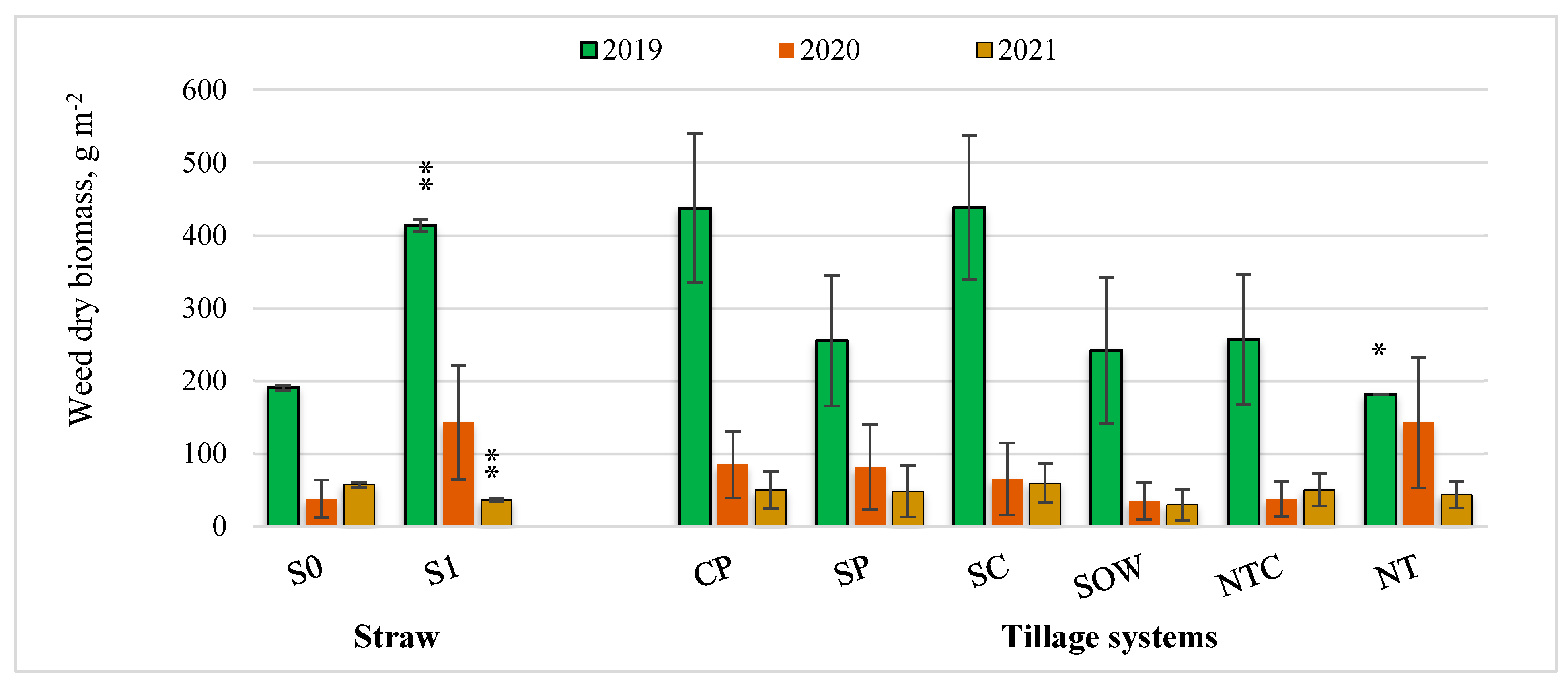
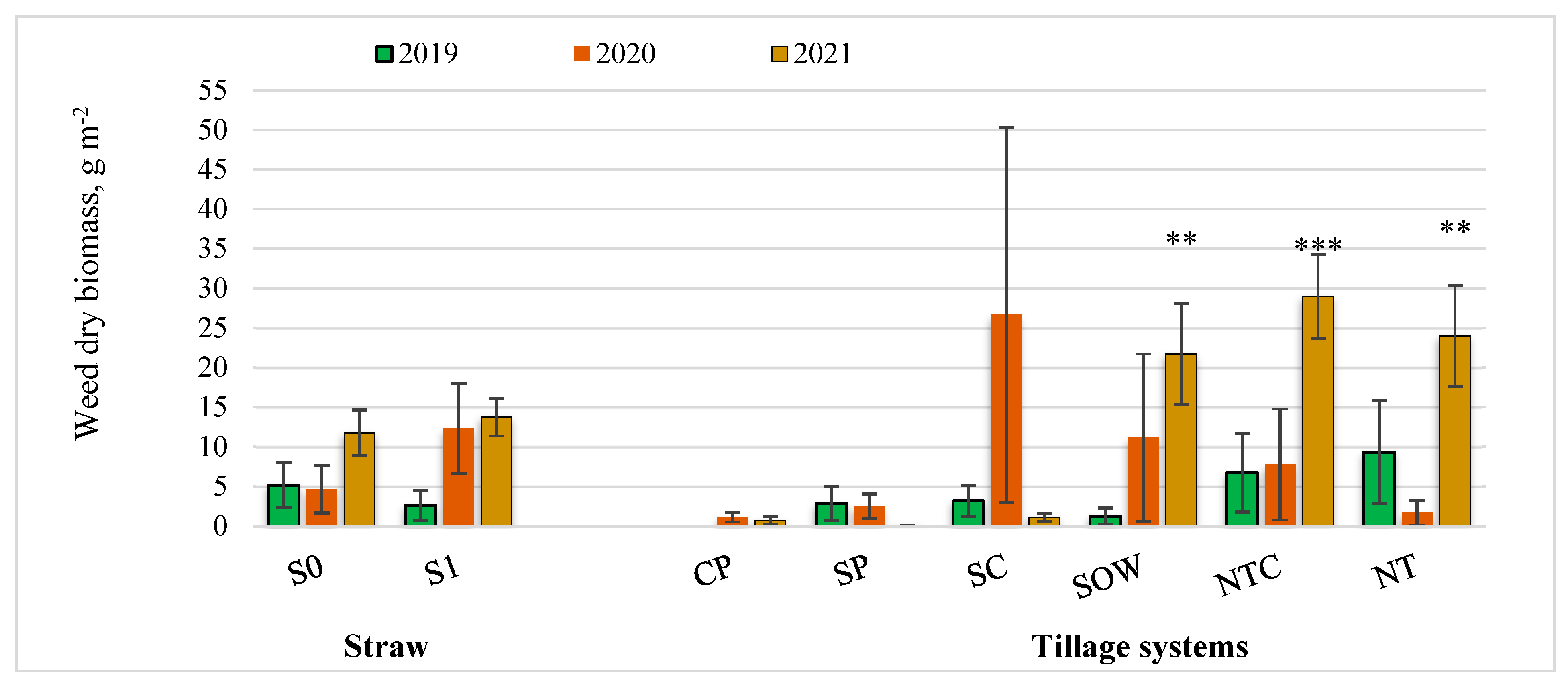


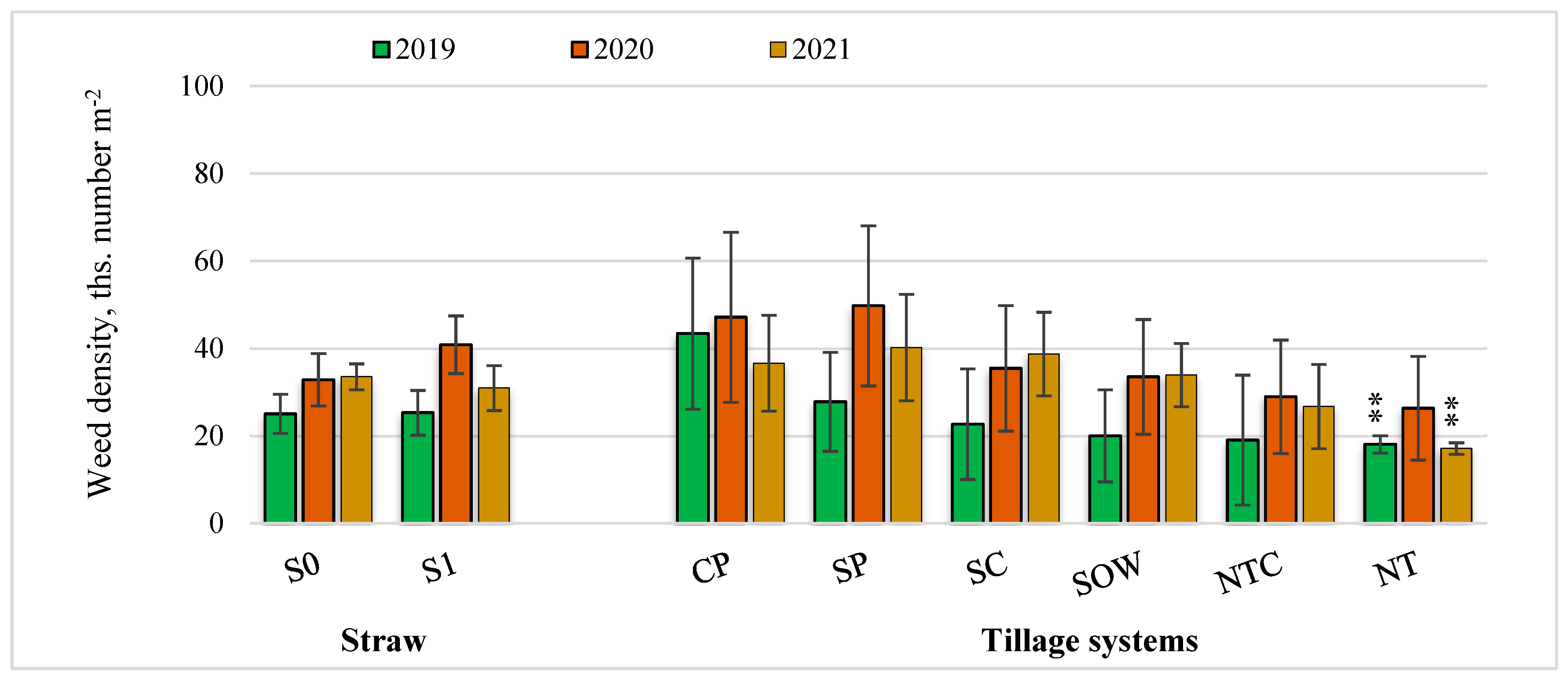
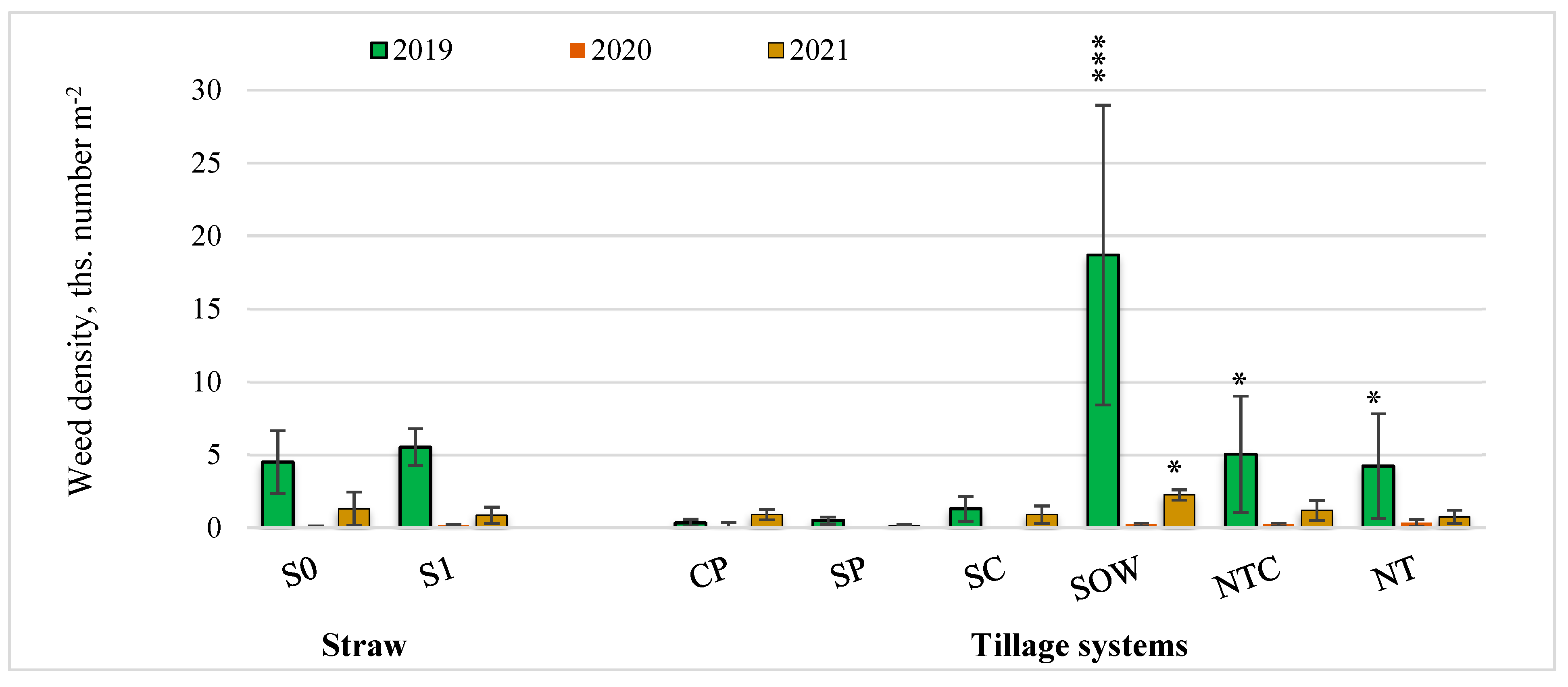
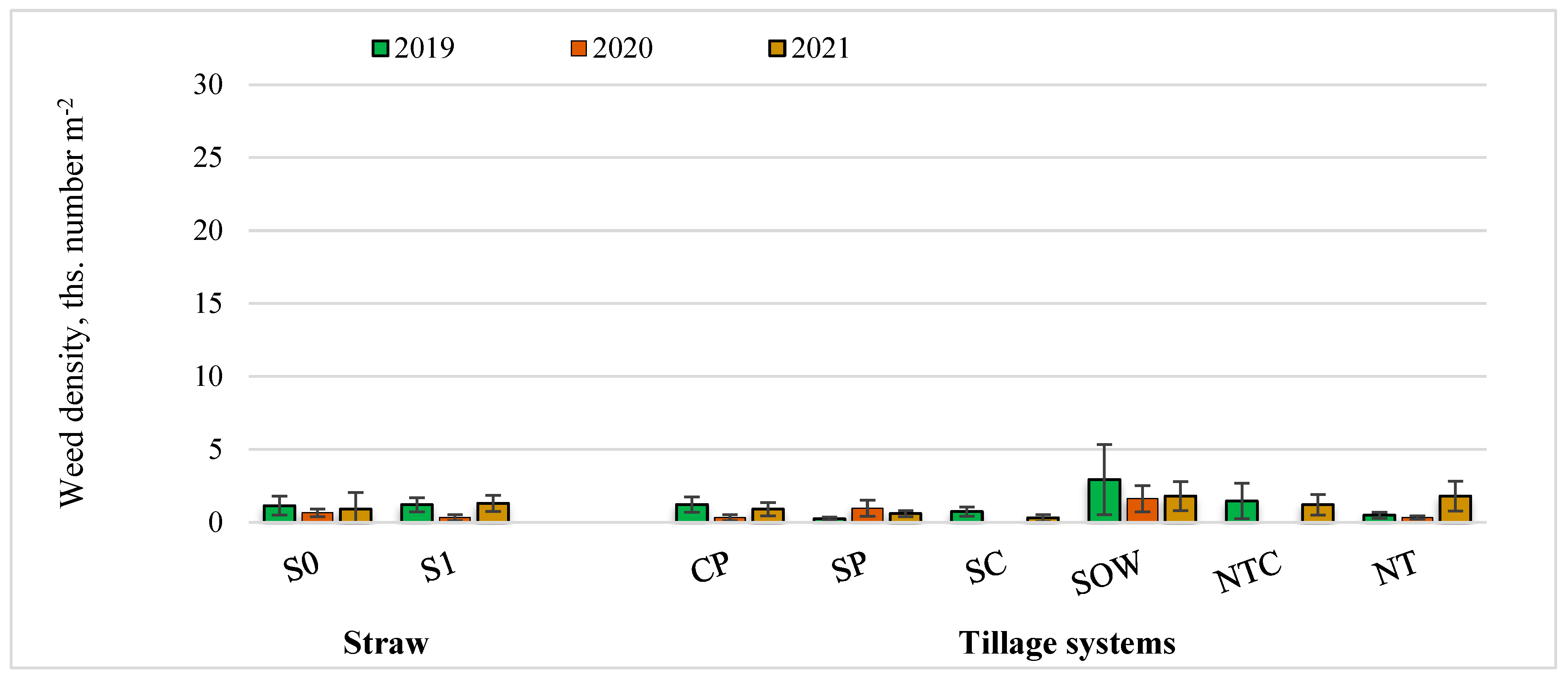
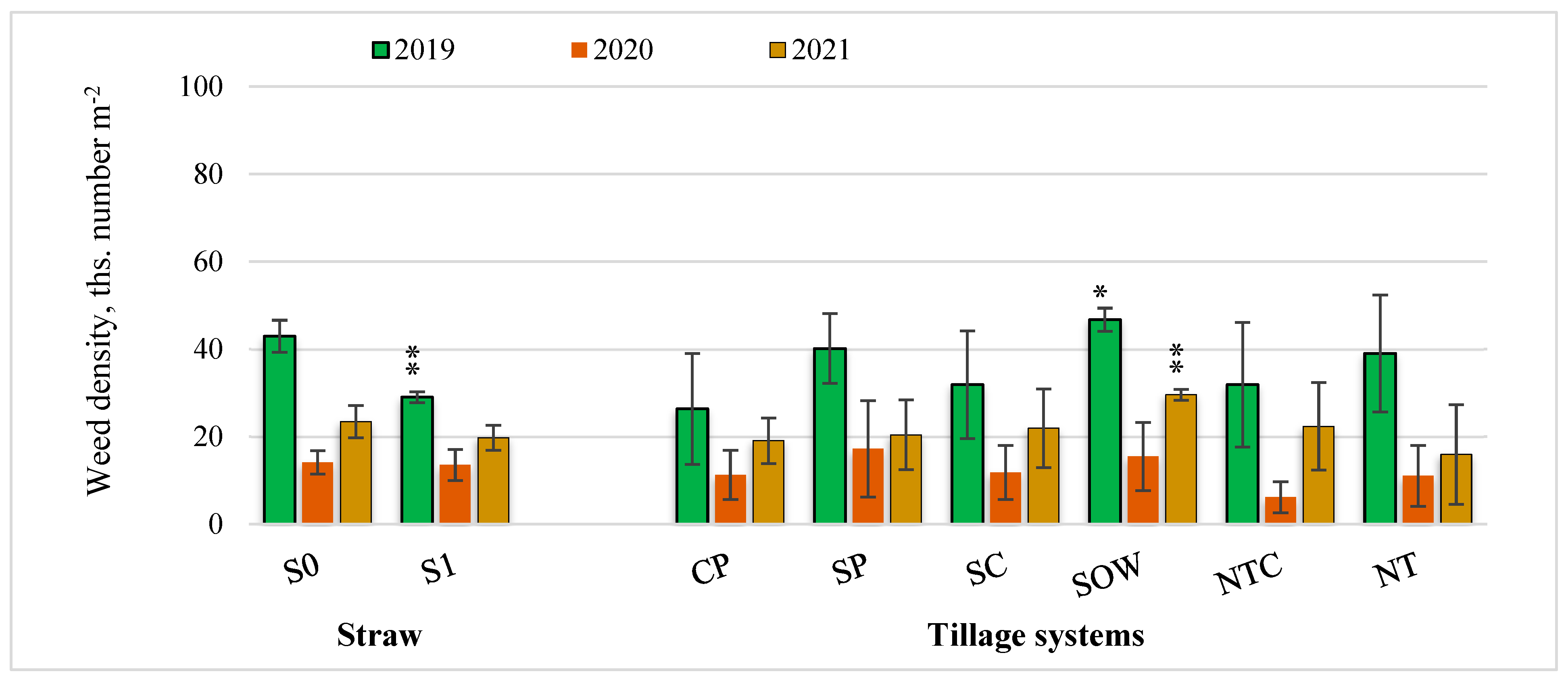
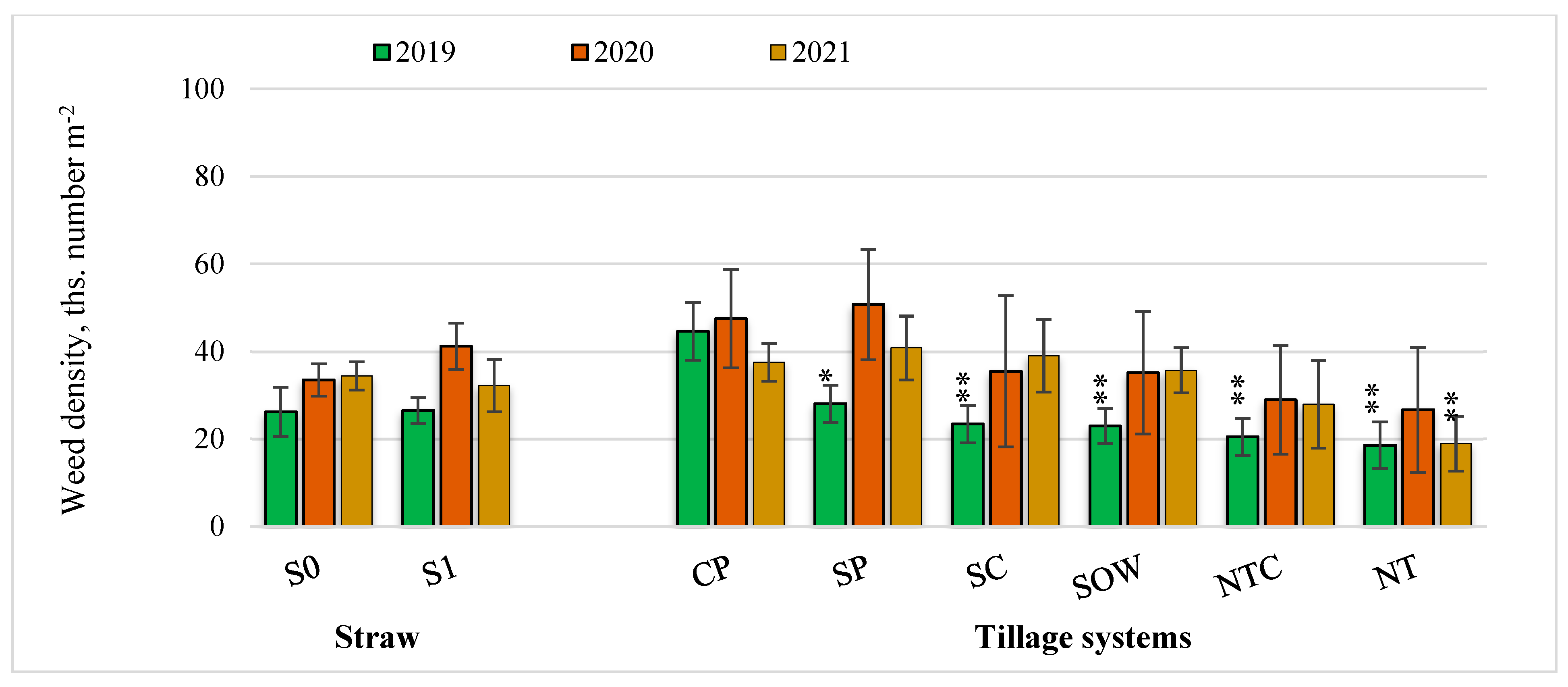
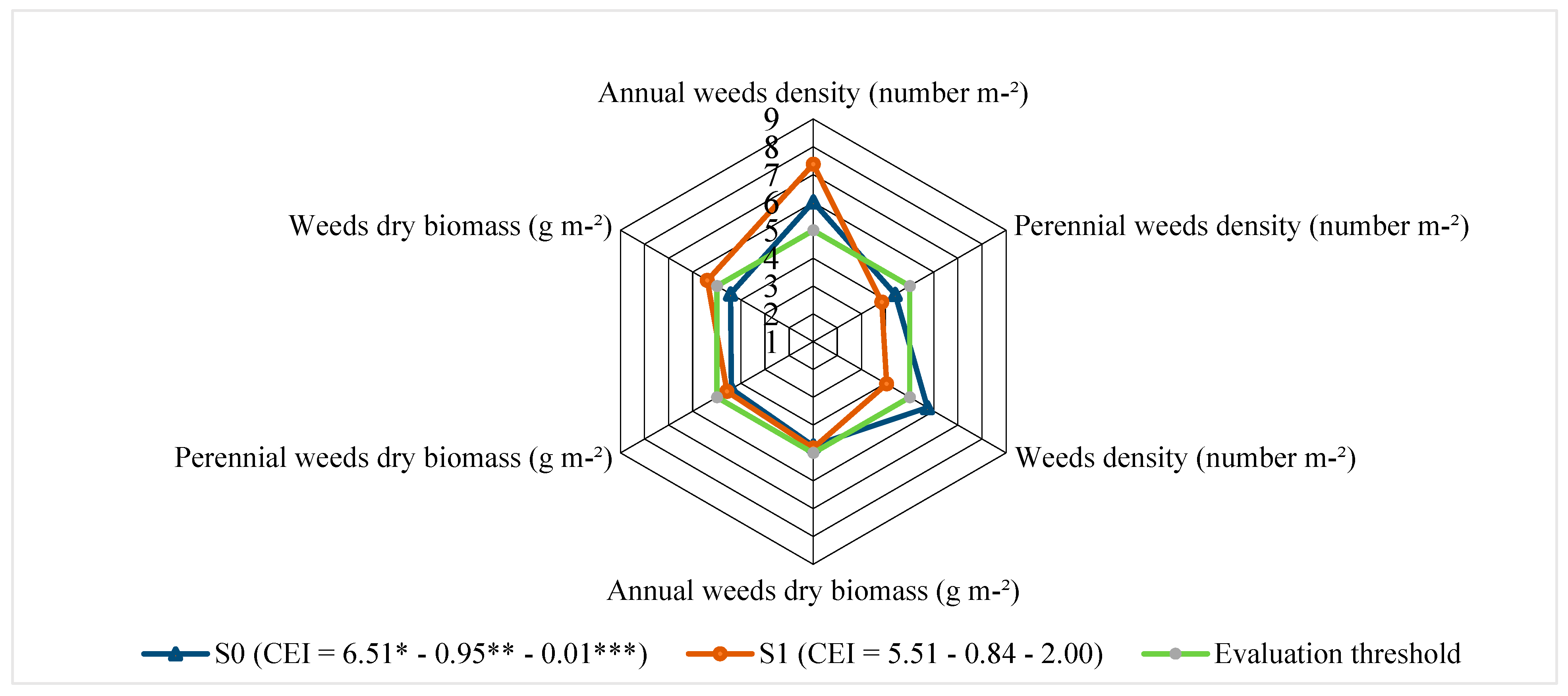

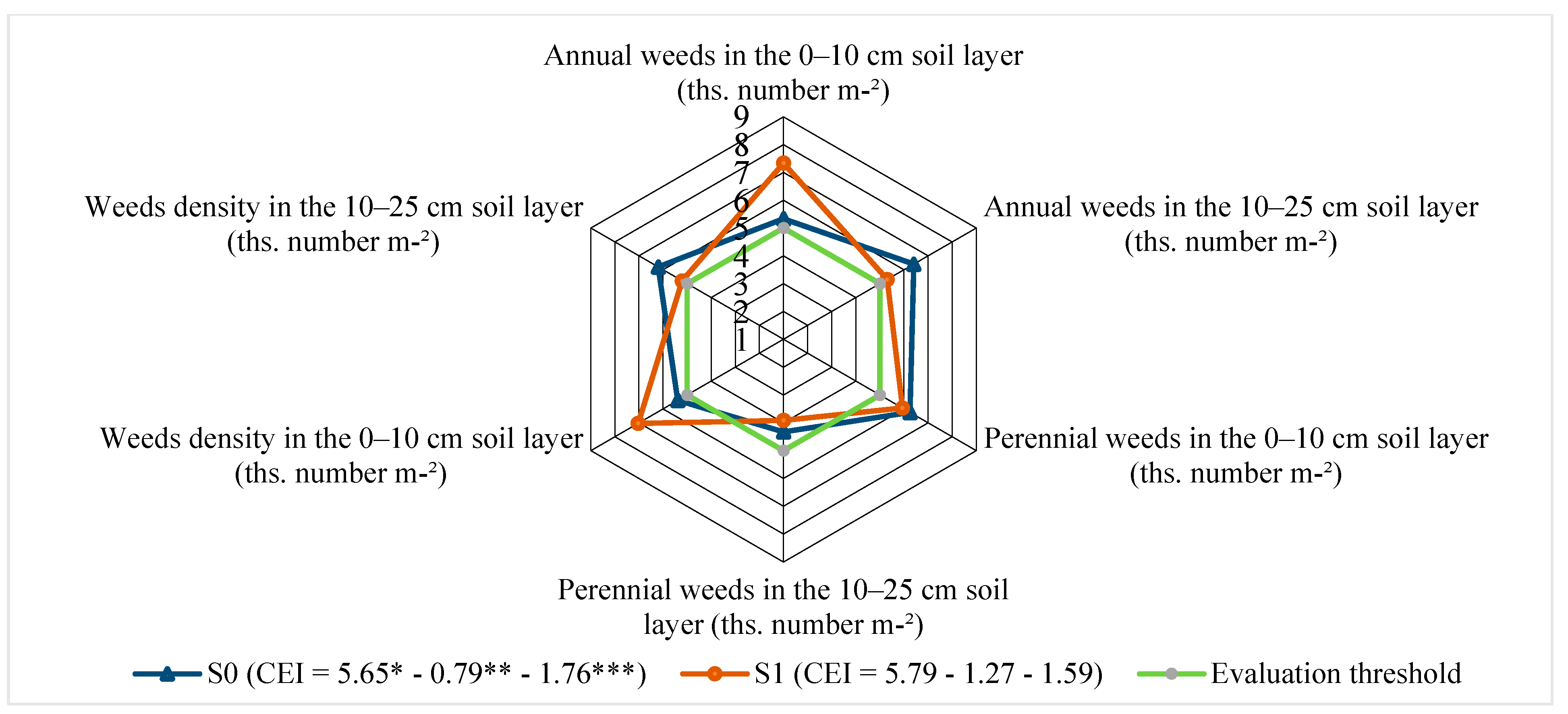

Disclaimer/Publisher’s Note: The statements, opinions and data contained in all publications are solely those of the individual author(s) and contributor(s) and not of MDPI and/or the editor(s). MDPI and/or the editor(s) disclaim responsibility for any injury to people or property resulting from any ideas, methods, instructions or products referred to in the content. |
© 2025 by the authors. Licensee MDPI, Basel, Switzerland. This article is an open access article distributed under the terms and conditions of the Creative Commons Attribution (CC BY) license (https://creativecommons.org/licenses/by/4.0/).
Share and Cite
Aušra, S.; Vaclovas, B.; Alfredas, S.; Vaida, S.; Lenkis, A.; Rasa, K. Weed Abundance, Seed Bank in Different Soil Tillage Systems, and Straw Retention. Agronomy 2025, 15, 1105. https://doi.org/10.3390/agronomy15051105
Aušra S, Vaclovas B, Alfredas S, Vaida S, Lenkis A, Rasa K. Weed Abundance, Seed Bank in Different Soil Tillage Systems, and Straw Retention. Agronomy. 2025; 15(5):1105. https://doi.org/10.3390/agronomy15051105
Chicago/Turabian StyleAušra, Sinkevičienė, Bogužas Vaclovas, Sinkevičius Alfredas, Steponavičienė Vaida, Anicetas Lenkis, and Kimbirauskienė Rasa. 2025. "Weed Abundance, Seed Bank in Different Soil Tillage Systems, and Straw Retention" Agronomy 15, no. 5: 1105. https://doi.org/10.3390/agronomy15051105
APA StyleAušra, S., Vaclovas, B., Alfredas, S., Vaida, S., Lenkis, A., & Rasa, K. (2025). Weed Abundance, Seed Bank in Different Soil Tillage Systems, and Straw Retention. Agronomy, 15(5), 1105. https://doi.org/10.3390/agronomy15051105








